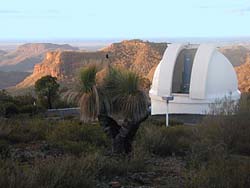This area deals with the fundamental laws and building blocks of nature and how they interact, the properties and the behavior of matter, and research into space and time and their structures.
innovations-report provides in-depth reports and articles on subjects such as astrophysics, laser technologies, nuclear, quantum, particle and solid-state physics, nanotechnologies, planetary research and findings (Mars, Venus) and developments related to the Hubble Telescope.

Scientists have not yet found a way to actually make time run backward, but in the cutting-edge world of recent acoustics research, they have shown a way to make sound waves run backward in a kind of ultra-focused reverse echo. By the technology known as time-reversal acoustics, sound waves – in exact reverse order from the original sound – echo directly and very precisely back to their source point.
The technology promises a wide array of applications, including medical applications such a

The hunt for space rocks on a collision course with Earth has so far been pretty much limited to the Northern Hemisphere. But last week astronomers took the search for Earth-threatening asteroids to southern skies. Astronomers using a refurbished telescope at the Australian National University’s Siding Spring Observatory discovered their first two near-Earth asteroids (NEAs) on March 29. NEAs are asteroids that pass near the Earth and may pose a threat of collision. Si

Home is the place we know best. The Milky Way, our Galaxy, is the exception to the rule, however: Our knowledge of our nearest stellar neighbours has long been seriously incomplete and – worse – skewed by prejudice concerning their behaviour. In the past, stars were selected for observation because they were thought to be ’interesting’ in some sense, not because they were typical of stars in general. Naturally, this gave a biased view of the evolution of our Galaxy – that serves as the prototype of

A rare celestial event was captured by NASA’s Chandra X-ray Observatory as Titan — Saturn’s largest moon and the only moon in the Solar System with a thick atmosphere — crossed in front of the X-ray bright Crab Nebula. The X-ray shadow cast by Titan allowed astronomers to make the first X-ray measurement of the extent of its atmosphere.
On January 5, 2003, Titan transited the Crab Nebula, the remnant of a supernova explosion that was observed to occur in the year 1054. Although Saturn and

Results of 1001 observing nights shed new light on our Galaxy
Unknown history
Home is the place we know best. But not so in the Milky Way – the galaxy in which we live. Our knowledge of our nearest stellar neighbours has long been seriously incomplete and – worse – skewed by prejudice concerning their behaviour. Stars were generally selected for observation because they were thought to be “interesting” in some sense, not because they were typical. This has resulted in

Cornell University researchers already have been able to detect the mass of a single cell using submicroscopic devices. Now they’re zeroing in on viruses. And the scale of their work is becoming so indescribably small that they have moved beyond the prefixes “nano” “pico” and “femto” to “atto.” And just in sight is “zepto.”
Members of the Cornell research group headed by engineering professor Harold Craighead report they have used tiny oscillating cantilevers to detect masses as small